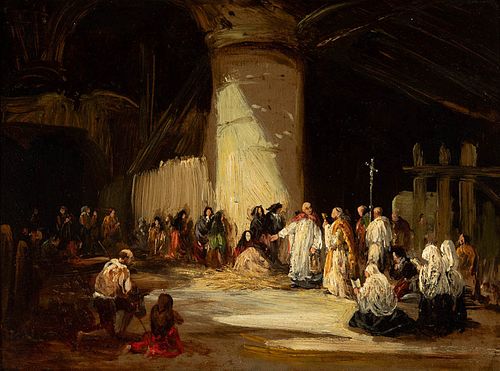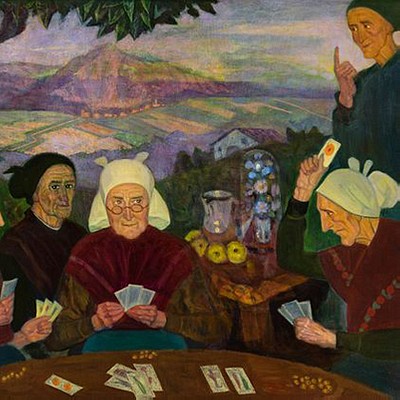Spanish school of the XIX century. Circle of EUGENIO LUCAS VELÁZQUEZ (Madrid, 1817 - 1870). "Rural Mass". Oil on copper.
Lot 17
About Seller
Setdart Auction House
Carrer Aragó 346
Barcelona
Spain
Setdart Subastas was born in 2004 and is currently the first online art auction in Spain with solidity, prestige and reliability guaranteed by our more than 60,000 users. Setdart has a young, dynamic and enterprising team ready to successfully manage the purchase and sale of art works through custom...Read more
Estimate:
EUR€1,500 - EUR€1,800
$1,562.50 - $1,875
Absentee vs Live bid
Two ways to bid:
- Leave a max absentee bid and the platform will bid on your behalf up to your maximum bid during the live auction.
- Bid live during the auction and your bids will be submitted real-time to the auctioneer.
Bid Increments
| Price | Bid Increment |
|---|---|
| EUR€0 | EUR€10 |
| EUR€200 | EUR€25 |
| EUR€500 | EUR€50 |
| EUR€1,000 | EUR€100 |
| EUR€3,000 | EUR€200 |
| EUR€5,000 | EUR€500 |
| EUR€10,000 | EUR€1,000 |
| EUR€20,000 | EUR€2,000 |
| EUR€50,000 | EUR€5,000 |
About Auction
By Setdart Auction House
Dec 14, 2021
Set Reminder
2021-12-14 08:00:00
2021-12-14 08:00:00
America/New_York
Bidsquare
Bidsquare : 19th & 20th Century Fine Art
https://www.bidsquare.com/auctions/setdart-auction-house/19th-20th-century-fine-art-7992
Gaudi, Sorolla, Torres Garcia, Maclet, TSUGUHARU FOUJITA, Benjamin Palencia Setdart Auction House sofia@setdart.com
Gaudi, Sorolla, Torres Garcia, Maclet, TSUGUHARU FOUJITA, Benjamin Palencia Setdart Auction House sofia@setdart.com
- Lot Description
Spanish school of the XIX century. Circle of EUGENIO LUCAS VELÁZQUEZ (Madrid, 1817 - 1870). "Rural Mass". Oil on copper. Measurements: 20 x 26 cm; 45 x 50 cm (frame). By its aesthetic and formal characteristics, the work that occupies us can be ascribed to the circle of Eugenio Lucas Velázquez, whose works were characterized by the use of a spirited brushstroke and uninhibited invoice, without drawing concerns, with a dense and impastoed matter of great chromatic richness and with the presence of strong chiaroscuro. Lucas Velázquez achieved great success as a painter of manners and scenes of fantastic and sinister character, as well as with a multitude of characters, although it is true that he was also an excellent landscape painter and portraitist. Eugenio Lucas was the Spanish romantic artist who best understood Goya's art. Trained in the neoclassicism of the Academy of San Fernando, he soon turned his training around and devoted himself to studying Velázquez and, above all, Goya, whose works he admired and copied in the Prado Museum. From the master, Lucas will develop a personal and imaginative painting, of fantastic visions and unleashed passions. Apart from his Goyaesque themes, in 1850 he painted the now disappeared ceiling of the Teatro Real in Madrid, and later he was named honorary chamber painter and knight of the order of Carlos III by Queen Isabel II. As a good romantic, he made several trips, among which his stays in Italy, Morocco and Paris stand out. He achieved great success as a painter of manners and scenes of fantastic and sinister character, although it is true that he was also an excellent landscape painter and portraitist. His work is well represented in the Prado Museum, and also in other centers such as the Bilbao Fine Arts Museum, the National Art Museum of Catalonia, the Lázaro Galdiano Museum, the British Museum, the Metropolitan Museum of New York and the Goya Museum in Castres (France).
- Shipping Info
-
In-house shipping available. Please inquire at admin@setdart.com.
-
- Buyer's Premium



 EUR
EUR CAD
CAD AUD
AUD GBP
GBP MXN
MXN HKD
HKD CNY
CNY MYR
MYR SEK
SEK SGD
SGD CHF
CHF THB
THB














